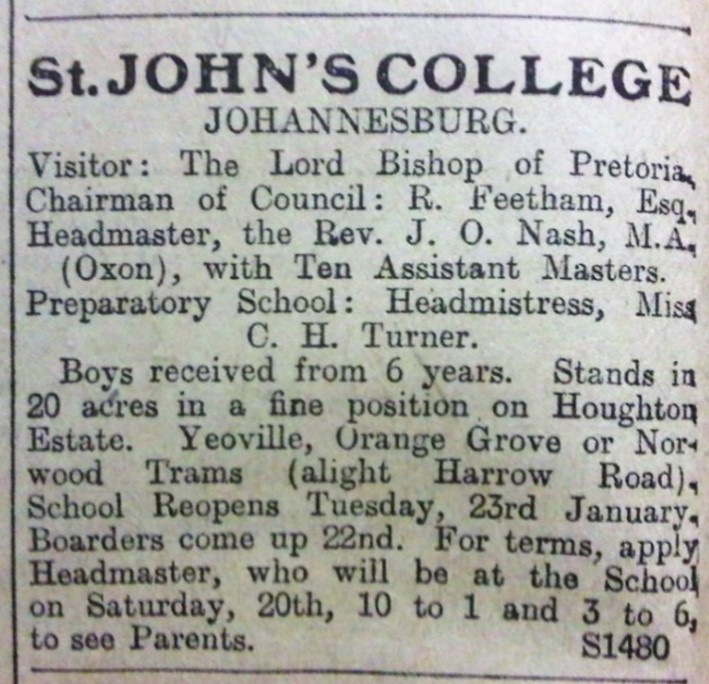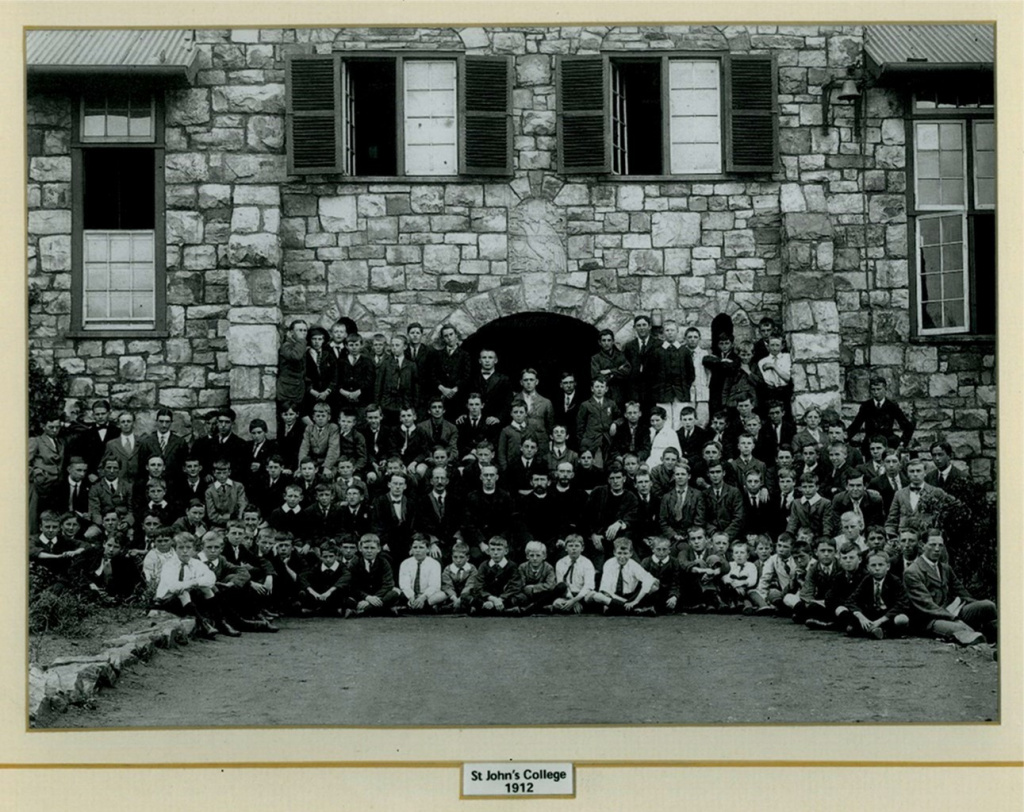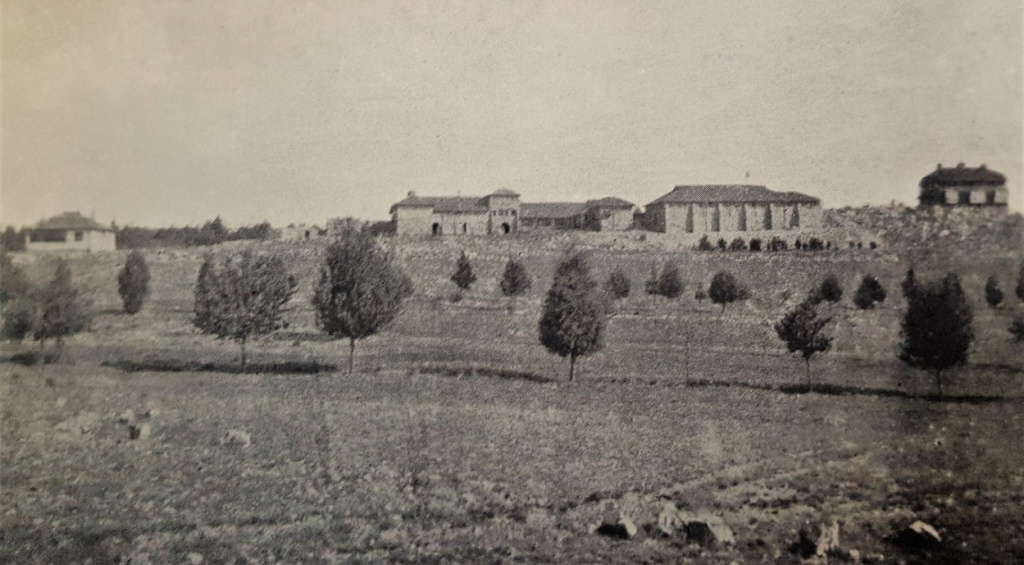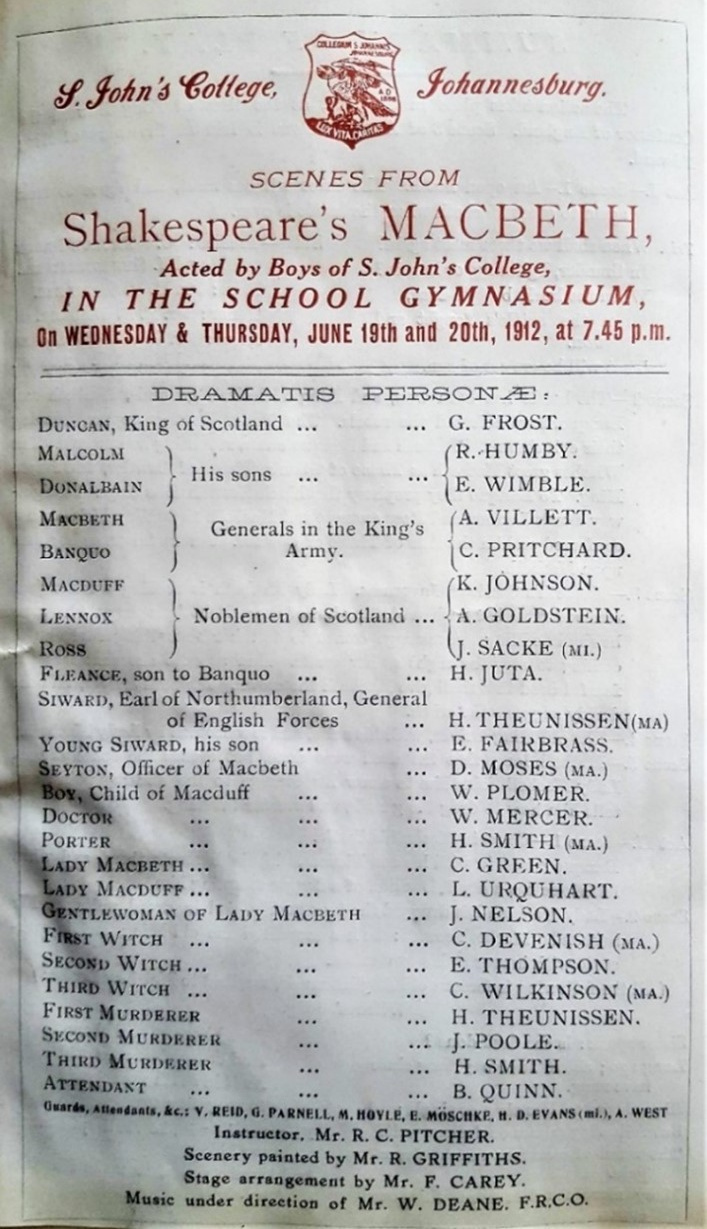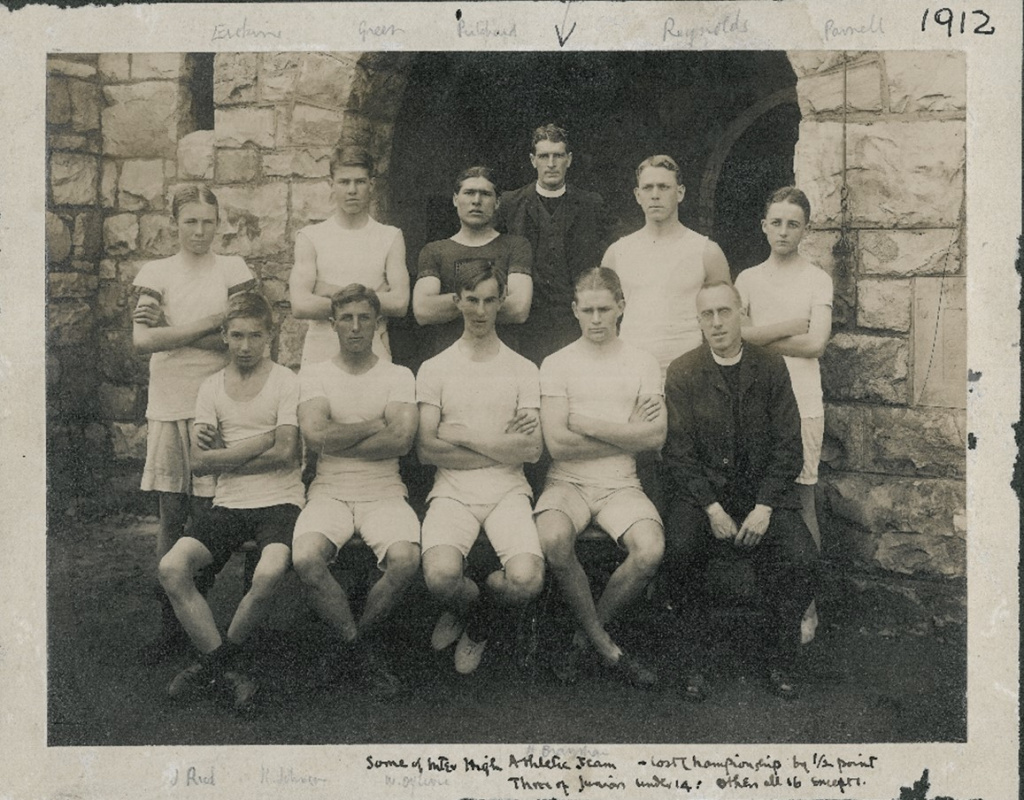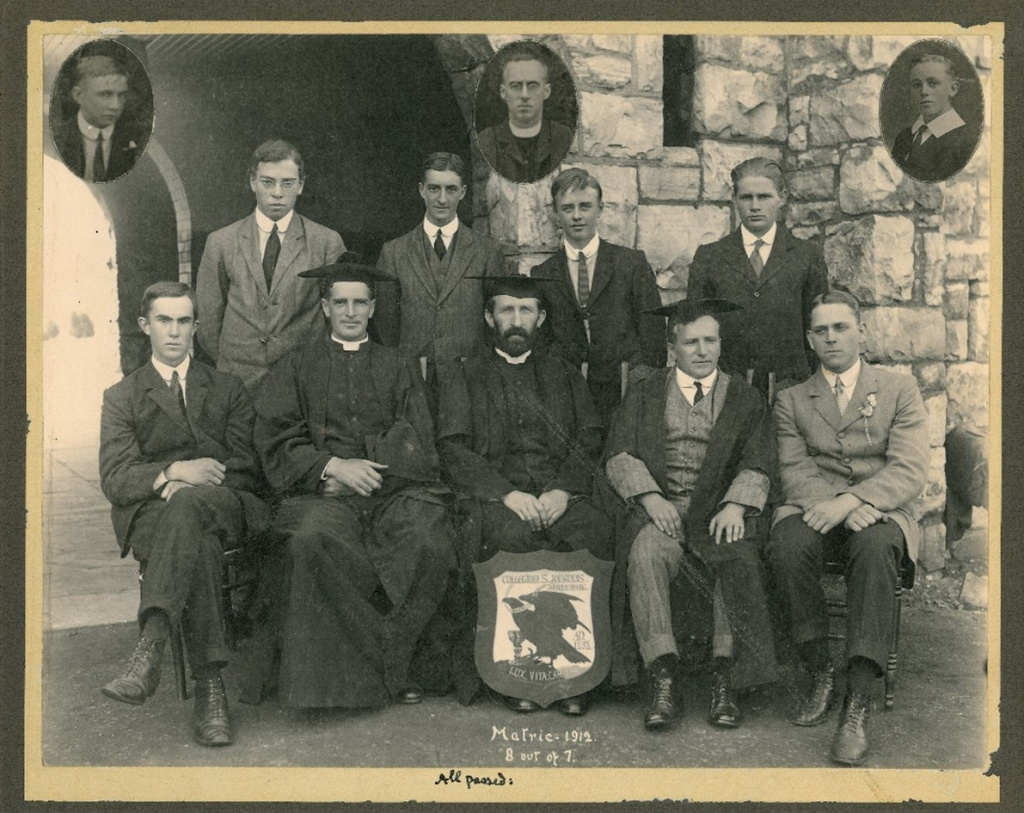by Dr Daniel Pretorius, Chairman of the Heritage Committee
When St John’s College opened for Lent Term on 23 January 1912, no fewer than 179 boys were in attendance. A further eleven enrolled at the beginning of Easter Term. Lack of space forced the Headmaster, Fr James Okey Nash, to turn away several applicants for positions in the boarding house and the Preparatory School. Thus, in the six years since 1906, when the Community of the Resurrection had taken charge of an embattled school with only forty pupils, there had been a dramatic upswing in the College’s numerical fortunes.
The acute shortage of boarding accommodation for senior boys prompted Fr Nash and the College Council to rent a house, known as Croom Lodge, in Muller Street, Yeoville. It was within easy walking distance from the College. Fr Hill took up residence there with eight boarders, as an interim measure until boarding facilities at the school could be expanded.
This casts some light on the historical development of the house system at St John’s. It is common nowadays to refer to the ‘traditional order’ of the College houses (as distinct from the Prep houses): Nash, Hill, Clayton, Thomson, Alston, Clarke, Hodgson, Fleming, Runge. For example, it is in this ‘traditional order’ that newly elected College prefects are announced at Speech Day, and it is the sequence in which they are listed in the College diary. At inter-house events, the houses’ names are called out in this order.
These conventions have generated an assumption that the ‘traditional order’ reflects the historical chronology in which the houses were established. But that is, by and large, a fiction – one of those popular myths that acquire general credence in old institutions by dint of frequent repetition. It is characterised by a modicum of truth but closer scrutiny reveals a more nuanced historical reality.
As a matter of fact, four houses were originally created simultaneously in 1907: Mr Alston’s, Mr Thomson’s, Mr Nash’s (or ‘the Headmaster’s’) and Mr Rakers’. That was the sequence in which the houses were listed in the early years: Alston, Thomson, Nash, Rakers. We see this in the house lists produced in 1907, 1908 and 1910. Interestingly, we also find the occasional reference to Mr Lowden’s House, but that seems to have been an ephemeral establishment.
These houses were created mainly for administrative and pastoral purposes, and for the purpose of competition in inter-house sport contests. Initially these houses had no physical existence. They had no common rooms of their own. In the College’s original boarding facilities, no distinction was made between the various houses. All of this only came later.
Mr Rakers passed away in September 1910. Fr Hill then became housemaster of Rakers’ House, which subsequently became known as Hill’s House. Clayton House, as we shall see, came into existence much later – long after Clarke House’s ancestral precursor, Gate House, had been established. Likewise, a Form VI house, though not known as Runge House, existed some years before Hodgson and Fleming were created.
New faces in the staff common room in 1912 were those of Messrs E. W. Mole B. A. (London), R. Law Wrathall B. A. (Oxon) and P. Huisinga (Groningen), as well as Miss Huxley, who assisted Miss Hutcheson in the Prep while Miss Turner was on furlough in England.
The annual swimming gala was held on 16 February. Eric Bell (Thomson), who had won the national 100 yards swimming championship for boys in 1910 and the Transvaal men’s 100 yards handicap in 1911, won the senior competition. A boy who rejoiced in the names of John Harry David Cyril Holliday (Thomson) was the runner-up. In the middles age group, the top swimmers were Rutland Peters (Alston) and Derric Fleischer (Nash). Victor Reid (Thomson) and Allen West (Nash) came first and second respectively in the junior age group, while little Hamish Howie (Nash) won the beginners’ title. The House Relay Race caused wild excitement. Nash’s House won, their team consisting of Harold Brayshaw (captain), Charles St Leger Devenish, Charles (‘Mossie’) Green and Gilbert Westacott Reynolds. Mr G. E. Devenish donated a ‘handsome’ challenge cup for the House Relay Race.
On Shrove Tuesday, 20 February, a ‘new institution’ known as the Entertainment Society, under the direction of Mr Ralph Griffiths, made its debut and gave a performance ‘for the boys’ own delectation’. It was a merry evening, with items performed by Mr Griffiths and Mr Hodges, a sword dance by Allen West, conjuring by Charles de Villiers Pritchard, and a piano piece by Brayshaw maior (a ‘beautiful musician, who played for our daily prayers’). Subsequently, on St Mark’s Day, the company acted a ‘very funny piece’ called ‘Freezing a Mother-in-Law’. Mr Griffiths, as the unfortunate mother-in-law, was excellent.
The school went up to St Aidan’s Church, Yeoville, on Ash Wednesday, 21 February, for the Commination Service. Fr Thomson gave a very good address. Although it has now largely fallen into desuetude, the Commination Service was traditionally celebrated on the first day of the penitential season of Lent, and was intended to remind the faithful of their iniquity and that those who did not repent would be confronted by God’s wrath and judgement.
Meanwhile, the Lent Term cricket season had started on none too encouraging a note. The College 1st XI, captained by William Ogilvie (Alston), received a drubbing by an innings and eighteen runs from H. G. Freeman’s XI. This team was led by Harry Greville Freeman (Alston, 1911), who had still been a member of the College 1st XI a few months earlier.
Prospects brightened considerably with victories by 142 runs over A. L. Sterton’s XI, by an innings and nine runs over the South African School of Mines and Technology (the predecessor of the University of the Witwatersrand), by 158 runs over Marist Brothers’ College, and by a single run over East Rand Proprietary Mines Juniors.
St John’s played against Jeppestown High School at St John’s on 28 February. St John’s batted first and Charles Pritchard (Hill), who opened the batting, patiently remained at the crease for two hours while wickets tumbled around him. He scored 34, and received support from the lower-order batsmen Percy Johnstone (Thomson) (14) and Harold Brayshaw (Nash) (26). In this manner, St John’s scraped together a total of 110.
When Jeppe went in to bat, Bell maior bowled very fast and took 5/38, but Jeppe’s opening batsman, Longhurst, made a heroic and solitary 52 before he fell to a magnificent catch by Bell minor in the long field. In an exciting finish, Jeppe were dismissed for 98, the next highest score being 16 extras. Alfred Goldstein (Hill) took 2/6 and Bell minor took 2/20. St John’s won by twelve runs.
The following day, St John’s received a visit from the Nourse Mines XI, whose team included the South African captain, Percy Sherwell (who had acquired eternal fame when, batting at number 11 in his debut Test match, he had participated in a last-wicket partnership of 48 runs to secure South Africa’s first ever victory over England, by one wicket, at the Wanderers in January 1906). Nourse Mines scored 178 (Ormsby 52; Ogilvie 2/22, Archibald Jordan 2/41). St John’s reached a promising 91/4 but were dismissed for 124 (Pritchard 27, Bell maior 26, Frost 23), thus losing by 54 runs. The wicket of Gerald Frost (Nash) was a ‘very difficult wicket to get.’
St John’s hosted King Edward VII School on 2 and 9 March. In the first innings, St John’s were dismissed for a paltry 60 (McCulloch 6/18), only Ogilvie and Pritchard reaching double figures. K. E. S. scored 104 in their first innings, Johnstone taking 5/18 and Bell maior 3/17. The St John’s second innings produced a better performance, Pritchard scoring 28 and Bell maior 43* to enable St John’s to declare at 150/5, thus setting K. E. S. a target of 107 for victory.
In the K. E. S. second innings, Goldstein took 3/28 and the Bell brothers took two wickets apiece to have K. E. S. on the brink of defeat, having slumped to 67/7 at stumps. Thus, St John’s came tantalisingly close to snatching victory from the proverbial jaws of defeat. But K. E. S., who (by their own account) ‘were saved only by time from a defeat we well deserved,’ won on the first innings.
The season ended with victories by three and 116 runs respectively over the Clergy XI and a team from St Alban’s Cathedral, Pretoria. The Old Boys awarded the average bat to Willy Ogilvie (Alston), who had a season’s aggregate of 762 runs (the highest achieved until then by a St John’s boy) at an average of 34.63, and who had scored two centuries. The ball for the best bowling was given to Eric Bell.
On 5 March, the Johannesburg Schools XVI played against the Transvaal Cricket Union XI at the Wanderers. As always, the Schools team was captained by Mr Atfield (who provided coaching at both St John’s and Jeppe). He insisted that the boys should field first: ‘You feed ‘em up with cake and ginger beer at lunch time and then they are no good for anything.’
Opening the bowling for the boys was Eric Bell of St John’s: ‘a particularly well set-up youth ... he is certainly the most promising of the [schoolboys’ fast bowlers], having a fine free style, with the arm well over and the knack of pitching the ball well down on to the wicket’. White (‘the Marist Brothers little googly merchant’) took 5/33 as the T. C. U. XI was dismissed for 173. Frank Mitchell (a Cambridge Blue in cricket, rugby and athletics, and who had played Test cricket for both England and South Africa) scored 49. At stumps, the boys had 16/1, with Pritchard on 2*. Unfortunately, the second day’s play was rained out.
On 30 March, the College boys participated in a large gymnastic display at the Wanderers, directed by Mr Barend Vieyra. Several hundred boys and girls from various schools took part in the display. A St John’s boy, Revel Duke Calvert (Hill), was selected as leader for all the boys. The object of the event was to raise funds to send South African representatives to the Olympic Games in Stockholm, Sweden, scheduled to take place in July 1912.
As it transpired, several South Africans excelled at the Olympic Games: Kennedy McArthur won the gold medal in the marathon, with Christian Gitsham winning the silver medal; Rudolph Lewis won the gold medal in the cycling race, over a distance of 198 miles; and, most significantly, Charles Lyndhurst Winslow O. J. won gold medals in the singles and doubles tennis events, teaming up with Harold Kitson in the doubles. Fr Nash wrote: ‘So we have our little share in the glory of McArthur, Gitsham, Lewis, Winslow and Kitson.’
On Maundy Thursday, 4 April, the St John’s boys sang the Eucharist at St Aidan’s Church, Yeoville. The collection raised an amount of £6 8s. 3d. for the benefit of work done by the Witwatersrand Working Lads’ Institute among indigent and unemployed juveniles. The Institute was a philanthropic initiative of the Anglican Church, in which the Rt Revd Michael Furse (the Bishop of Pretoria and Visitor of St John’s College) and the Revd Mr Darragh were involved.
On Ascension Day, 16 May, the first Old Boys’ Gaudy was held. The event’s origins can be traced back to Ascension Day in 1907, when a Past v Present football match had been played. A similar match had been played on Ascension Day in 1908, when Fr Nash had expressed the hope that this would become an annual event. It did, and from 1909 onwards it became customary to start the Ascension Day reunion with Holy Eucharist at St Aidan’s Church.
Fr Nash suggested that the annual reunion day be called a ‘Gaudy’. ‘The name,’ he explained, ‘given to college commemorations in Oxford, comes from gaudeo, meaning, for we all know Latin here, rejoice.’ The day’s proceedings commenced with a choral celebration at St Aidan’s. The Revd Sidney Dunstan O. J. was the celebrant, and the Bishop delivered a ‘vigorous’ sermon, holding up the ideal of a school and school life.
This was followed by a procession to the school’s new sanatorium, which was blessed by the Bishop. Fr Nash described the sanatorium (which was located in the area now occupied by the new Prep buildings, above the Valley Pool) as ‘a comely little building with ward, nurse’s room, kitchen, &c.’ He was glad that, apart from the fact that a boy had been lodged in the sanatorium for a few days as a precautionary measure, ‘its only use has been to serve as a handy guest room; while the glazed stoep is a wonderfully warm sitting room in winter.’ And so, besides providing accommodation for an occasional guest, the sanatorium had fortunately had little further occupation ‘than to look on at the vaccination of all masters and boarders by Dr Pershouse during the outbreak of smallpox in the town.’
The Old Boys recorded a 2-1 victory over the school in the Past v Present football match on Gaudy Day. Afterwards, the College Council entertained the Old Boys to dinner at Luthje’s Langham Hotel in Kerk Street; some forty Old Boys were present. Mr Greathead (‘one of our Governors’) was in the chair. After dinner there were some excellent songs, recitations, banjo pieces by Bernard Stokes, Bielski, Arthur Holliday (1899) and Leonard Denny (Alston, 1911). (Three Bielski brothers attended St John’s before the Anglo-Boer South African War. It is unclear which one of them played the banjo on this occasion.) Mr J. J. Hoyle (‘another of our Governors’) told ‘some good legal stories’.
In 1911, the headmaster of Winchester College, Dr Hubert Burge (who had since been made Bishop of Southwark), had visited St John’s. On 29 May 1912 Canon Spooner, the Warden of New College, Oxford (the other famous foundation of William of Wykeham (1323-1404), the former Bishop of Winchester) came to address the boys at St John’s. Two members of the St John’s Council, the Hon. Hugh Wyndham M. P. (later the fourth Baron Leconfield) and Mr Richard Feetham, were New College alumni. Fr Nash said, ‘it does us good to feel we have such links with the noble old seats of learning in the Home Land.’
Feetham and Wyndham (and others associated with St John’s, such as Herbert Baker and Geoffrey Robinson, previously the editor of The Star and soon to become the editor of The Times in London) had been members of Lord Milner’s ‘Kindergarten’ during his tenure as High Commissioner for Southern Africa, and were part of his influential ‘Round Table’ network. Feetham (an Old Marlburian) later became a judge of the Appellate Division of the Supreme Court, as well as Chancellor of the University of the Witwatersrand, in which capacity he opposed legislation excluding black students from ‘white’ educational institutions.
A few weeks later, in mid-June, the College staged a production of Shakespeare’s Macbeth, ‘a difficult one for boys to tackle.’ Under the guidance of ‘our veteran coach’, Mr R. C. Pitcher, and Messrs Ralph Griffiths and Frank Carey, the boys did wonderful work. As in previous years, Mr W. Deane (the organist at St Mary’s Church) was in charge of the music.
A performance was given at the Rietfontein lazaretto on 15 June. ‘It seemed to give much pleasure to the patients; it is some little thing the boys can do for the sick,’ said Fr Nash. Next a party of sixty (the full cast and chorus) was taken to perform in the Kleinfontein Hall in Benoni on 17 June. The Benoni Herald enthused:
‘Some of the young actors possessed talent of quite an exceptional order, and seem to grasp the spirit of Shakespeare’s great play with remarkable understanding … . To Master A. Villett must be accorded a special measure of praise. His powerful rendering of the name character was nothing short of marvellous … . Mention must be made of Master C. Green, who made a remarkably good Lady Macbeth … . Banquo was well represented by C. Pritchard, and Master G. Frost was a very good Duncan, King of Scotland. … L. Urquhart was a sweet and pretty Lady Macduff.’
Fr Nash wrote that the boys and staff would never forget the ‘royal tea’ provided by their hosts, ‘or the terrific rush to catch the last train at the station two miles off. However, we sailed in triumphant at the last moment.’ The performance in Benoni raised £16 for the Gymnasium fund.
Afterwards, on the evenings of 19 and 20 June, performances were given in the Gymnasium. The Rand Daily Mail critic wrote: ‘The pupils of S. John’s College have many times previously presented scenes from the plays of Shakespeare, but never before have they equalled in point of acting and elocution the scenes from Macbeth as played last night to a very large audience.’ Fr Nash added that the ‘little eight-year-old Billy Plomer (child of Macduff) [and destined to become famous in literary circles in England later in life] played most prettily, and touched all mothers’ hearts.’
The Witwatersrand Council of Education arranged a competition between the Johannesburg high schools in reciting Shakespeare. It was held at the School of Mines on 16 August, before a crowded audience. Eleven schools entered, and four competitors were allowed from each school. St John’s boys won three of the four senior prizes: the Second Prefect, Arthur Villett (Alston), who recited ‘Is this a dagger?’ from Macbeth, and Kenneth Johnson (Alston) and Harry Smith (Thomson), who, as Caliban and Trinculo, brought down the house with speeches from The Tempest.
Boxing lessons continued to be popular, with Sergeant-Major Hall coming on Friday afternoons to instruct boys in the art of pugilism in accordance with the Marquess of Queensberry Rules. ‘It no doubt is capital exercise,’ wrote Fr Nash, ‘and the sergeant is a first-rate instructor.’ Captain MacLeod of the Transvaal Scottish soon succeeded Sergeant-Major Hall as the boxing instructor at St John’s.
The College’s football first team, led by Willy Ogilvie (Alston), recorded mixed results. In friendly matches there were victories over St Mary’s English Church Men’s Society (5-1), Government Mining School (2-0 and 3-2), Oriel (5-1), Marist Brothers’ College (2-1) and Railway Juniors (2-1). But there were defeats against the Old Boys (1-2), Jeppe (0-2) and Fr Alston’s team (2-3), while the match against K. E. S. was drawn (0-0).
In league matches, St John’s beat Marists but lost to Jeppe. The team had strong defenders in Harold Brayshaw (Nash) and Gilbert Stanford (Nash) (who was also ‘a capital pianist’), while Ogilvie was a fine centre half. Unfortunately, the centre forward, John Daniel (‘Jack’) Poole (Alston), was ‘damaged’ in the match against the Old Boys, and so was unavailable for a time. Alston’s House took the lead in the inter-house competition.
In the under 15 league, St John’s played against Jeppe Central (to be distinguished from Jeppestown High School) in the league semi-final. There were no goals during regulation playing time. Twenty minutes’ extra time also produced no goals, although St John’s squandered an opportunity to secure victory by missing a penalty kick. The match was then replayed and was won decisively by Jeppe Central, who went on to win the final.
Fr Nash proudly reported on various improvements around the school grounds, but added that ‘we have to go on gradually as we can afford it.’ A fruit orchard had been planted on the ‘north slope’ but, like the entire country, ‘had suffered with the drought.’ Some passage ways had been paved with slate (‘a great comfort!’), some drainage works had been carried out, and the centre portion of the Front Field (now Mitchell Field) had been levelled. But, added Fr Nash, ‘there is that swimming bath we so much desire!’
On 3 September, Earl Albert Grey, the former Governor-General of Canada, visited St John’s College. He said that Sir Leander Starr Jameson (who had been imprisoned briefly on account of his eponymous raid into the Transvaal in 1895, but who had since been Prime Minister of the Cape Colony) had recommended that he come to St John’s, as Jameson had ‘heard good reports of it.’ He urged boys to wonder, ‘what can I do for my country, for the Empire?’ He also encouraged boys to consider farming (the profession ‘which would take long to get overstocked’) as a future career. Speaking about relations with ‘the natives’, the Earl said ‘the strength of British rule was the spirit of fairplay,’ and that boys ‘must learn to understand the natives.’ The boys cheered their illustrious visitor heartily.
The annual athletic sports produced a profusion of school records in the open age category: Cyril Wackrill (Alston) in the quarter mile (58.15 seconds), Gilbert Reynolds (Nash) in the long jump (19 ft 7 in), and Charles Pritchard (Hill) in the mile (5 mins 16.25 secs). Alston’s House won the half mile house team relay race. Reynolds (who was also a good swimmer and a fine pianist) was the victor ludorum, winning not only the long jump but also the 110 yards sprint and the high jump.
Several Old Boys attended the sports day, and Lawrence McKowen (1903) won the old boys’ race over 220 yards (23.25 secs). Afterwards the Old Boys’ annual dinner was held at Luthje’s Langham Hotel. There was a ‘good muster’, with the Bishop of Pretoria in the chair. Fred van den Berg (Alston, 1908) delivered an excellent speech.
Fr Nash reflected on recent achievements of some of the Old Boys. Walter Albu (1904) had recently returned from Trinity Hall, Cambridge; Edmund Selke (Nash, 1908) was at Hertford College, Oxford; William Currie (1904) had achieved third position in the country in the final LL. B. examination; John Moodie (Rakers, 1910) had won the philosophy prize at Transvaal University College; Eric Bell (who had left St John’s at the end of Lent Term) was third in his class at the School of Mines and Technology, and had been distinguishing himself at cricket and football; Harry Marsh (Rakers, 1910) had been making good scores in cricket; Hugh Hughes (1907) had won the national amateur heavy-weight boxing title; and Hyman Patlansky (Nash, 1911) was achieving success at Edinburg University.
So, too, boys who had recently transferred from St John’s to schools in England were distinguishing themselves: Trevor Benson (Rakers / Hill, 1911) was ‘winning all possible prizes’ at Blundell’s School in Devonshire; Huntley Shillito (Thomson, 1910) had been swimming and running bravely at Oundle in Northamptonshire; and Oswald Reid (Thomson, 1910) was senior prefect and captain of cricket and football at Radley College in Oxfordshire.
The good performances produced at the athletic sports day meant that St John’s went to the Inter-High School Sports, held at the Caledonian ground in Pretoria on 25 September, ‘modestly hopeful of getting a point or two.’ It was ‘a horrible day, with wind and dust worthy of the worst South African traditions.’ The morning heats were disappointing, with several St John’s boys being eliminated. The College team was then entertained at luncheon by the Bishop of Pretoria (the Visitor of the College), and returned to the Caledonian fortified by that ‘genial and hearty hospitality’ to try again.
‘Soon,’ Fr Nash wrote, ‘we began to smile.’ Kenneth Johnson came second in the half-mile (2 min 9 secs), Harold Brayshaw won the hurdles (18.25 secs), Willy Ogilvie won the cricket ball throw (99 yds, 1 ft, 10 in); and Charles Pritchard came second in the mile. These successes left St John’s leading the competition, having chalked up 6 points, with K. E. S. on 5½ and Jeppestown on 4. The last event, the quarter-mile, was to decide the championship. Alas, the K. E. S. runner came in ahead of Cyril Wackrill, and so K. E. S. won the competition by half a point. ‘Then off to the station, stopping at the Bishop’s house once more for tea.’ As it transpired, this was the closest St John’s would ever come to winning the Inter-High athletics championship.
The Advent Term cricket season started with the 1st XI match against K. E. S., played on 26 October and 2 November. St John’s scored 94 (Theunissen 25), McCulloch and Betts taking five wickets apiece for K. E. S. The Edwardians then scored 229/5. St John’s scored 89/5 in the second innings, of which Pritchard made 30 and Brayshaw (‘a hard-hitting left-hander ... who with more patience will make a splendid bat’) 29*. St John’s lost on the first innings.
Fr Nash recorded that All Saints’ Day, 1 November, had become ‘a kind of annual commemoration of our origin before the war as choir school of S. Mary’s, with Rev. J . T. Darragh as our first founder.’ The custom had developed for the Rector of St Mary’s Church, Archdeacon Seaton (‘one of our Governors’) to arrange a special tram for the St John’s boys, ‘and we come down [to St Mary’s] and sing the Eucharist. The girls of S. Margaret’s also attend.’
After some refreshment, all repaired to the Wanderers Club for the College’s annual gymnastic display, under the guiding hand of the instructor, Mr Vieyra. The Transvaal Leader reported that the display was ‘excellent’ and that ‘the repeated applause of the large audience was a testimony of their appreciation of the boys’ efforts.’ The display included figure-marching (‘the boys in their neat white uniforms, jerseys and shorts, making a charming picture’), dumbbell exercises, apparatus work on rings, parallel and horizontal bars, horse and buck.
The fencing squad (‘attired in the orthodox costume, white starched shirts and collars, black ties and dark knicker bockers’) went through a series of evolutions and gave a display of exercises, both with and without masks. The brothers Theunissen gave an exhibition of boxing, and a squad of juniors put up some wrestling bouts. (Hugh John Theunissen, who was also ‘a smart speaker in debate’, and Bernard Finnerty Theunissen, both Alston, were the fraternal pugilists.)
The Transvaal Leader report concluded: ’The display reflects the greatest credit on the instructor, and the school is to be congratulated upon the excellence of its young gymnasts.’
On 30 October and 6 November, St John’s hosted Jeppestown’s cricket team. St John’s batted first and was in trouble at 70/5 but recovered to reach 186. Jack Poole made 69 by vigorous batting before he was caught ‘in the country’. Jeppe, having been 71/4 at stumps, scored 273 (Longhurst 116; Goldstein 6/56) on the second day. Batting again, St John’s was dismissed for 75, only Theunissen (‘a beautiful free bat, a fair fast bowler [and] kept wicket well’) and Allen Bell making double figures. For Jeppe, Goetzsche took 10/97 in the match.
The 2nd XI atoned for the 1st XI’s defeat by beating their Jeppe counterparts by two wickets. Allen Eastwood scored 54, Clifford Reynolds (Nash) took 4/29 and Walter Greathead (Alston) 4/10.
St John’s beat Marist Brothers’ College by six wickets (Pritchard scoring 59) and Langlaagte Gold Mining Company by ten runs. The match against Mr S. B. Stokes’ XI was drawn, while the match against Chemists Cricket Club was lost.
The first match ever played between St John’s and Pretoria Boys’ High School was won by the latter. Pretoria B. H. S. had been founded in April 1910 through the amalgamation of Pretoria College (one of the ‘Milner schools’) and the Afrikaans-medium Eendracht School. The new school remained a dual-medium school until 1924 when the Afrikaanse Hoër Seunskool (Affies) opened.
The 2nd XI beat Twist Street Old Boys, Jeppe and Marists but lost to K. E. S. and Pretoria. The 3rd XI beat Pretoria, drew with Marists and lost to Jeppe. The 4th XI beat Twist Street Government School and Yeoville Government School. The Juniors beat Park Town School, K. E. S. and Pretoria, but lost the return match against K. E. S.
The regular match between the Transvaal Cricket Union XI and Johannesburg Schools was played at the Wanderers on 11 December. Charles Pritchard (Hill) opened the batting for Johannesburg Schools and scored 20. Willy Ogilvie (Alston) came in with the score at 66/8: he ‘played all the good balls and scored off everything off the wicket ... he continued to play a straight bat and generally shaped well until, hitting out to get his 50, he skied one to cover’, thus going out on 49. His ‘innings was quite the best of the Schools’ innings, for he put very few balls into the air, got most of his runs with orthodox shots, was enterprising and, moreover, he was not once beaten by the fine bowlers that were on during his innings’. The Schools scored 181. Other St John’s boys in the team were the wicket-keeper, Hugh Theunissen, and Alfred Goldstein (who took 1/19). The Transvaal XI won by one wicket.
Prize Day was held on 12 December 1912. In the morning, the school went up to St Aidan’s, Yeoville, for the Eucharist Thanksgiving. The prize-giving ceremony was preceded by the annual gymnastic competition, which was won by Kenneth Johnson (Alston), with Cyril Holliday (Thomson) being the runner-up. After tea in the quad there was a concert in the gymnasium. The programme included renditions of ‘Here’s a Health unto His Majesty’, ‘Rule Britannia’, ‘The Empire Flag’ and ‘O, Little Town of Bethlehem’.
The speaker was the Chairman of Council, Mr Feetham, who expressed the belief that it was good for South Africa to have independent schools, able to develop their own traditions and to train boys with their own distinctive type of character. ‘Only let the boys see to it that their tradition is sound.’ He said that South Africa wanted men who could think out problems for themselves rather than look around to find the biggest crowd to follow. Also, men were wanted whose watchword was thoroughness in their work.
William Ogilvie won the Form V English and French prizes, as well as the Form prize and the Latin Gold Medal. Cecil Colville Carr (who was the captain of the 2nd XI) received the Divinity prize, Gilbert Reynolds the Dutch prize, Hugh Robinson the Mathematics prize, and Walter Greathead the Science prize. Cyril Holliday was the recipient of the Old Boys’ Good Fellowship award.
The report on Prize Day shows that the Prep School boys were in Classes I – IV (the equivalent of what would today be the Pre-Preparatory School). The College boys entered in Form I, and then gradually escalated through Form II, Lower III, Form III, Lower IV, Remove, Form IV and Lower V to Form V. There was to be no Form VI for several decades, and eventually boys up to Form III (today Upper III) found their home in the Prep. Lower IV and Remove were eventually switched around.
Fr Nash bade farewell to Miss Hutcheson, who had assisted Miss Turner in laying the foundations of the Prep School, which now had sixty pupils. Miss Hutcheson was returning to Ireland, and she was being replaced by Miss Jean Stone.
Towards the end of 1912, Fr Nash was appointed an Honorary Canon of the Diocese by the Bishop of Pretoria. Although Nash was elevated to the status of Canon, at St John’s he continued to be called Fr Nash, or simply Mr Nash. Indeed, the brethren of the Community of the Resurrection who were on the staff at St John’s College were commonly known as ‘Mr Alston’, ‘Mr Thomson’, ‘Mr Hill’ etc.
Twelve St John’s boys sat the Cape Junior Certificate examination. All twelve passed, with Dudley Bertie David Moses receiving a first-class certificate. There were seven St John’s candidates in the Cape Matriculation, and another one who entered independently because the school did not think he was ready. All but two of them were only sixteen years old. All eight passed, so this was a ‘Grand Slam’ (to use Fr Nash’s ‘pardonably secular metaphor’). Francis Edgar Smart achieved a first-class pass in the Transvaal School Certificate, usually written a year before the matriculation exam.
Principal sources:
KC Lawson Venture of Faith: The Story of St John’s College, Johannesburg (1968); W Macfarlane Greater Than We Know: The History of St John’s Preparatory School (2004); ES Thompson Let Me Tell You: The Story of the First 73 Years of the Old Johannian Association (1976)
Transvaal Leader 27 February 1912, 10 June 1912, 12 December 1912; The Star 5 March 1912; Jeppestown High School Magazine December 1912; King Edward VII School Magazine June 1912; King Edward VII School Magazine December 1912
St John’s College Letter of Trinity Term 1909; Letter of Lent Term 1910; Letter of Trinity & Advent Terms 1911; Letter of Lent & Easter Terms 1912; Letter of Trinity & Advent Terms 1912; Letter of Trinity & Advent Terms 1913; The Johannian May 1956

